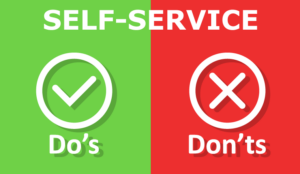Elizabeth Tobey at NICE explores the self-service revolution.
Perhaps it all started in 1822 in London with the first vending machine, a coin-operated dispenser of envelopes, postcards, and notepaper.
Since then, vending machines have evolved—self-service gas pumps in the sixties, supermarket self-checkout in the nineties, and airport check-in kiosks in the aughts.
Then the pandemic changed everything, abruptly shifting self-service from novelty to necessity. We all became digital natives virtually overnight: 40% of U.S. adults told Pew Research that they used digital technology or the internet in new or different ways compared with before the pandemic.
As a result, e-commerce sales surged to $870 billion in the U.S. in 2021, a 14.2% increase over 2022 and a 50.5% increase over 2019, according to the United States Census Bureau.
The top four food delivery companies in the U.S.—DoorDash, Grubhub, Uber Eats, and Postmates—brought in roughly $5.5 billion combined revenue from April to September 2020, more than twice as much as their combined $2.5 billion in revenue during the same period in 2019, according to MarketWatch reporting.
The Company/Customer Disconnect
While daily dinner-delivery may have cooled, the expectation for instant gratification has not. More than four in five (81%) consumers want more self-service options, according to NICE’s May 2022 Digital-First Customer Experience research, and 45% of customers are more likely to use self-service than before the pandemic, according to Acumen Research and Consulting.
Our research shows that businesses haven’t caught up with this major consumer shift. Businesses estimate that only 60% of consumers want more self-service options—a 21-point gap—and just 11% are prioritizing smarter self-service as part of their customer experience portfolios, despite 36% of consumers citing this as a top expectation.
In response, customers are going directly to the source: online search. In many ways, Google has become the universal contact centre.
Our recent research shows that 46% of consumers conduct a Google search as their first attempt at solving a product or service issue.
If this consumer behavior is surprising, you’re not alone: Just 15% of the businesses we surveyed believe that Google is their consumer’s first-choice resource, marking another critical misperception at play.
Getting Smarter About Self-Service
While consumers clearly want more self-service, they also want it to be smarter. The surge in the success of telehealth and online grocery ordering has transformed expectations. Instant is the new baseline. But most brands are not measuring up.
According to our research, just 15% of consumers are very satisfied with the self-service tools offered today. And companies surveyed overestimated this rate by almost 40 points, projecting that 53% of their consumers were very satisfied with their self-service tools.
Smarter self-service isn’t rocket science—consumers told NICE they simply want the ability to digitally self-address more complex tasks. But to achieve what consumers want, brands need to make self-service work better by empowering it with advanced artificial intelligence and data-driven technology.
The seemingly simple ask for smarter self-service is made complex by the omnichannel, seamless, personalized nature of customer engagement today, and has driven the majority of companies (52%) to accelerate their AI adoption plans this year, according to Forrester.
With AI at the helm, how can companies make smarter self-service a reality? A 2020 Gartner survey of 8,000 customers who had recently interacted with a customer service organization spotlighted seven attributes most likely to drive a smart self-service interaction:
- Clarity: How easy it is to understand or act on given information.
- Confirmation: The presence of messaging that indicates resolution.
- Control: The degree to which the customer can influence or give input on a solution.
- Credibility: The usefulness or relatability of information.
- Human touch: How well the self-service interaction mimics a live interaction.
- Personalization: The recognition of a customer’s relationship with the company.
- Variety: The ability to interact with the company in multiple, dynamic ways.
The Role of Self-Service and the Agent
Even as customers overwhelmingly seek self-service options, human agents—and their ability to manage the most complex and nuanced of issues—have become inherently more important.
Where self-service steps in to tackle mundane issues and tasks, agents are allowed to step up to better address critical customer needs when it matters most.
Identifying those high-stakes issues, and then orchestrating an associated customer journey, should be a top priority for customer service leadership.
Always making agent engagement an option is step one—a 2022 Harvard Business School working paper highlights how simply having the option to connect with a live human support person significantly helped relieve customer apprehension—but the ability to identify and seamlessly re-route customers through self-service to agent support must become a core capability for businesses as well.
Powered by proactive conversational AI, the role of agent can even evolve to include soothsaying. New AI-powered solutions interact with customers through their channels of choice to pre-empt needs before they reach out for service.
Armed with this intel, agents are empowered to initiate customer engagement to resolve a nascent need and add value in ways previously inconceivable in the traditionally reactive customer service dynamic.
The Future Is Digital
As a culture, our digital self-service preference is more than a passing fad. It’s a behavioral sea change. That means it’s time for our organizations to better align self-service strategies with customer expectations by orchestrating seamless, fluent customer journeys.
Digital is here to stay, and our customers have spoken. Listening is no longer an option. It’s a necessity.
This blog post has been re-published by kind permission of NICE – View the Original Article
For more information about NICE - visit the NICE Website
Call Centre Helper is not responsible for the content of these guest blog posts. The opinions expressed in this article are those of the author, and do not necessarily reflect those of Call Centre Helper.
Author: NICE
Published On: 14th Nov 2022 - Last modified: 15th Nov 2022
Read more about - Guest Blogs, NICE






 NICE is a leading global enterprise software provider that enables organizations to improve customer experience and business results, ensure compliance and fight financial crime. Their mission is to help customers build and strengthen their reputation by uncovering customer insight, predicting human intent and taking the right action to improve their business.
NICE is a leading global enterprise software provider that enables organizations to improve customer experience and business results, ensure compliance and fight financial crime. Their mission is to help customers build and strengthen their reputation by uncovering customer insight, predicting human intent and taking the right action to improve their business. 






























